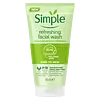What's inside
What's inside
 Key Ingredients
Key Ingredients

 Benefits
Benefits

 Concerns
Concerns

 Ingredients Side-by-side
Ingredients Side-by-side

Water
Skin ConditioningKaolin
AbrasiveEmulsifying Wax Nf
Cetyl Alcohol
EmollientGlycerin
HumectantTitanium Dioxide
Cosmetic ColorantBentonite
AbsorbentPhenoxyethanol
PreservativeMethylisothiazolinone
PreservativeParfum
MaskingHydroxyethylcellulose
Emulsion StabilisingDisodium EDTA
Bisabolol
MaskingCrocus Sativus Callus Extract
AntioxidantCurcuma Longa Callus Extract
Skin ProtectingSantalum Album Extract
CleansingPrunus Amygdalus Dulcis Oil
Skin ConditioningHoney
HumectantRosa Damascena Extract
MaskingGlycyrrhiza Glabra Root Extract
BleachingCicer Arietinum Sprout Extract
Skin ConditioningYogurt Extract
Skin ConditioningCI 77491
Cosmetic ColorantWater, Kaolin, Emulsifying Wax Nf, Cetyl Alcohol, Glycerin, Titanium Dioxide, Bentonite, Phenoxyethanol, Methylisothiazolinone, Parfum, Hydroxyethylcellulose, Disodium EDTA, Bisabolol, Crocus Sativus Callus Extract, Curcuma Longa Callus Extract, Santalum Album Extract, Prunus Amygdalus Dulcis Oil, Honey, Rosa Damascena Extract, Glycyrrhiza Glabra Root Extract, Cicer Arietinum Sprout Extract, Yogurt Extract, CI 77491
 Reviews
Reviews

Ingredients Explained
These ingredients are found in both products.
Ingredients higher up in an ingredient list are typically present in a larger amount.
Disodium EDTA plays a role in making products more stable by aiding other preservatives.
It is a chelating agent, meaning it neutralizes metal ions that may be found in a product.
Disodium EDTA is a salt of edetic acid and is found to be safe in cosmetic ingredients.
Learn more about Disodium EDTAGlycerin is already naturally found in your skin. It helps moisturize and protect your skin.
A study from 2016 found glycerin to be more effective as a humectant than AHAs and hyaluronic acid.
As a humectant, it helps the skin stay hydrated by pulling moisture to your skin. The low molecular weight of glycerin allows it to pull moisture into the deeper layers of your skin.
Hydrated skin improves your skin barrier; Your skin barrier helps protect against irritants and bacteria.
Glycerin has also been found to have antimicrobial and antiviral properties. Due to these properties, glycerin is often used in wound and burn treatments.
In cosmetics, glycerin is usually derived from plants such as soybean or palm. However, it can also be sourced from animals, such as tallow or animal fat.
This ingredient is organic, colorless, odorless, and non-toxic.
Glycerin is the name for this ingredient in American English. British English uses Glycerol/Glycerine.
Learn more about GlycerinPhenoxyethanol is a preservative that has germicide, antimicrobial, and aromatic properties. Studies show that phenoxyethanol can prevent microbial growth. By itself, it has a scent that is similar to that of a rose.
It's often used in formulations along with Caprylyl Glycol to preserve the shelf life of products.
Water. It's the most common cosmetic ingredient of all. You'll usually see it at the top of ingredient lists, meaning that it makes up the largest part of the product.
So why is it so popular? Water most often acts as a solvent - this means that it helps dissolve other ingredients into the formulation.
You'll also recognize water as that liquid we all need to stay alive. If you see this, drink a glass of water. Stay hydrated!
Learn more about Water